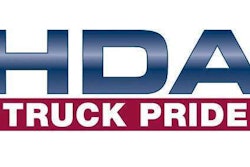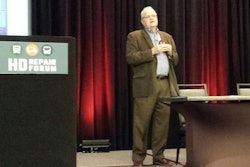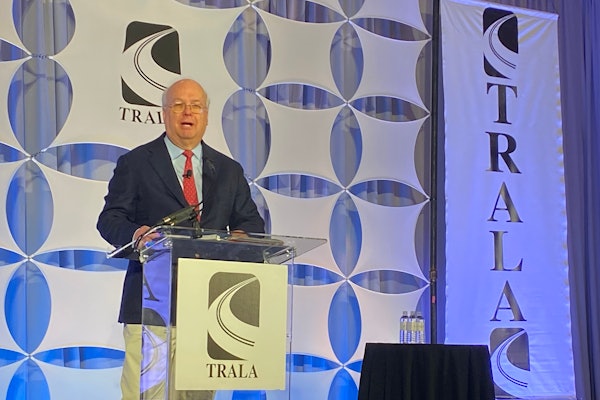The following comes from the March 2018 issue of Truck Parts & Service. To read a digital version of the magazine, please click the image below.
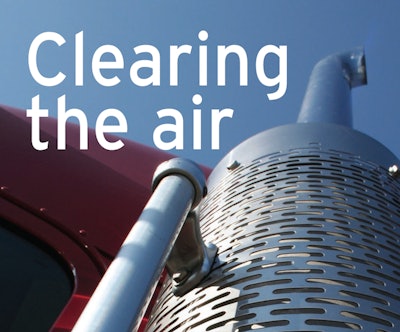
It started out as a thorn in the side of the trucking industry about a decade ago, when the Environmental Protection Agency (EPA), in response to a memorandum from President Barack Obama, began an initiative intended to reduce greenhouse gas emissions and improve fuel economy standards.
For the trucking industry, this meant the addition of an aftertreatment system that cuts down on vehicle emissions harmful to the environment.
Despite initial pushback about the installation of aftertreatment, the system should be relatively worry-free. “Generally speaking, a healthy engine equals a healthy aftertreatment,” says David Morse, customer quality manager within the emissions solutions business at Cum-mins Inc.
“If you take care of the engine and it’s behaving well, then your aftertreatment, for the most part, is going to [operate well],” Morse says. “Most truck owners would prefer not to have the complexity that additional components can add to their engine, whether that’s driven by legislation or other reasons. Our goal is to make them as trouble-free and invisible as possible.”
What can go wrong
However, not every truck’s engine out on the road is running at optimal performance and no truck is immune to an engine malfunction that could affect the aftertreatment system, which is a sophisticated piece of equipment made up of several components, including the diesel particulate filter (DPF), diesel oxidation catalyst (DOC), selective catalytic reduction (SCR) and diesel exhaust fluid (DEF) injectors, among other parts.
Poor engine maintenance or malfunction can disrupt the aftertreatment system in several ways, according to Matt Caton, product manager, Dorman Products Inc.
“Aftertreatment disruptions such as increased NOx emissions, rich or lean exhaust gas conditions, excessive carbon build-up and damage to the exhaust system will be the result of poor maintenance and component malfunctions,” Caton says. “The majority of these can be attributed to upstream failures including exhaust manifold and internal coolant leaks, EGR and turbocharger failures, leaking injectors and faulty engine management sensors.”
Dave Jerman, sales manager for aftertreatment parts supplier Roadwarrior, agrees, adding that in his experience the top three engine issues are turbo failures, which will soak the aftertreatment with oil; prolonged coolant leaks that will irreversibly harm the coating on DPFs and DOCs; and bad in-cylinder injectors that will cause hydrocarbon poisoning of the system.
Morse adds that excessive soot and ash can cause the DPF to fail and the NOx sensors can suffer thermal shock if a significant amount of water — while the truck is being power washed, for example — enters the tail pipe.
The good news is that “anything in the aftertreatment system is repairable or replaceable,” says John Pfennig Jr., Navistar director for global development. If an engine malfunction damages a component, that part can be repaired or replaced; an entirely new aftertreatment system wouldn’t be required. “There was a lot of thought put into serviceability by engineers when these systems were designed,” Pfennig adds.
These factors make it all the more lucrative to aftermarket parts and service businesses to stock aftertreatment parts to replace or repair parts and help vehicle owners maintain their systems. But to provide these services, technicians must know the ins and outs of the aftertreatment system, and that requires education and training.
Boning up on aftertreatment
“Even though it’s been over 10 years since this technology has been introduced in the on-road market, there’s still a surprising lack of knowledge in the industry,” says Jerman. “Training our customers and, ultimately, the truck owners and technicians who deal with this on a daily basis is important.” To that end, Roadwarrior, which sells parts through independent distributors and dealers, frequently offers webinars and on-site instruction.
“Education is paramount. There’s definitely a thirst and need to properly train these technicians,” Jerman says. “When we do these [presentations] we don’t just focus on Roadwarrior products, we talk about the aftertreatment as a whole and give a basic understanding of how it operates and what to look for.”
Dorman Products currently is developing a series of aftertreatment videos designed to educate the counter person and fleet maintenance manager, according to Brett Delp, product manager. The videos, available on Dorman Products’ website and YouTube channel, will cover everything from engine basics to breaking down each component in the aftertreatment system to how they work together. The videos will be part of Dorman University segments. These segments will test customers’ knowledge covered in the videos and raise awareness on products Dorman has available for each segment in the aftertreatment system.
Aftertreatment component provider APC Automotive Technologies educates customers by providing data on how its DuraFit aftertreatment products are designed and built with the same OEM-grade components as the original first-fit equipment, according to Jason Soika, vice president of sales, DuraFit, AP Emissions Technologies, a division of APC.
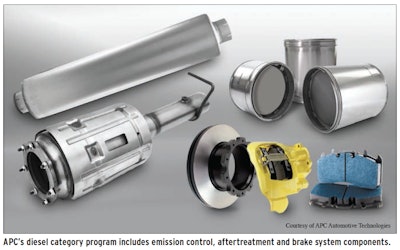
Industry associations, such as the Association of Diesel Specialists (ADS), are providing aftertreatment information, too. For example, during last year’s annual convention, the association held a seminar that included an overview of the aftertreatment system as well as service opportunities, according to David Fehling, the association’s executive director.
For customers of Daimler Trucks North America (DTNA) new to the aftertreatment system and its maintenance, the OEM reviews with them the operator’s manual and on-board diagnostics that signal to operators whether the emission system is functioning properly. The manufacturer also offers aftertreatment system videos that show the progression of the exhaust through the DOC, DPF and SCR, as well as explain fuel dosing and DEF dosing, according to Dale Allemang, director, regional service, DTNA.
Navistar tackles aftertreatment service training of its technicians with technical documentation, which varies by vehicle configuration; web-based training; and hands-on training, which amounts to approximately 95 percent of the time in the shop and 5 percent in the classroom, says Pfennig.
Maintaining the DPF
A common maintenance requirement associated with the aftertreatment system is the cleaning of the DPF, according to Allemang. The DPF is designed to trap soot from the diesel engine exhaust and eliminate fine particulates from entering the atmosphere. As the engine operates over time, soot and ash accumulate in the DPF. Among other factors, the rate of soot accumulation is a function of the load and speed that the engine is operating, typically referred to as the duty cycle, he explains.
When the filter is not running at an optimal level, a warning light alerts the driver, who has the ability to initiate an on-vehicle or passive regeneration (regen) of the DPF. When regenerating the DPF, “The engine is preprogrammed to go into a mode where it increases the temperature in the DPF, and the heat burns off that soot,” Pfennig says. “In most cases, it solves the problem, or self-heals.”
Although the filter has the ability to heal thyself, it still requires maintenance because ash, created by oil, also gets trapped in the filter, but doesn’t burn off in the regen cycle. Most commonly, the filter is removed to be baked in a machine and then goes through an air-puffing process, in which high-pressure air is blown through the filter to clean it, Pfennig says.
Although baking and blowing air through the filter might be more common, Allemang adds that Daimler’s preferred method is a liquid cleaning process that results in a DPF that’s in “like new” condition.
Suggested DPF maintenance intervals can vary dramatically based on myriad factors, such as the type and age of the engine, miles of service, the type of oil and how the vehicle is used, among other variables.
For example, for a 13-liter engine, Navistar lists service intervals based on the type of oil used, according to Pfennig. Using CJ4, which produces less ash, the DPF recommended service interval is 155,000 to 250,000 miles. Using a lesser-quality CI4, the suggested interval is 125,000 to 195,000 miles.
For Daimler, depending on the engine, a DPF can reach its ash limit between 300,000 and 800,000 miles, Allemang says.
Cummins might suggest service at a certain mileage, while other OEMs might recommend other maintenance intervals — it’s important for the customer to refer to published service manuals, says Morse. “There may be a difference in ash cleaning or service replacement intervals based on how the OEM wants to approach it and it’s really dependent on what the OEM has determined,” he adds.

Regardless of the intervals, at some point, a driver is going to need to service the DPF — or more — if something goes wrong with the vehicle that damages components in the aftertreatment system. The aftermarket industry must be ready to step in, experts say.
“Many trucks with aftertreatment systems are and have been out of warranty for many years now. This is causing an inherent need for aftermarket distributors to carry all of the latest aftertreatment products to keep up with their customers’ needs,” says Kevin Smith, field analyst, heavy duty, Dorman Products. “It is crucial for distributors and service providers, alike, to stock common aftertreatment parts to make sure they can provide the same level of uptime service as a dealer would for a vehicle that is still under warranty.”
Jerman agrees that it’s essential for distributors and service providers to carry and install aftertreatment components. “If service providers continue to ignore or fall behind and aren’t in a position to troubleshoot, repair or sell this aftertreatment technology, they’ll be turning away a growing number of customers who are forced to seek out OEM dealers or independent service providers that have invested in aftertreatment technology and service,” he says.
“It means having the parts in stock, it could be DPF cleaning machines, it could be diagnostic tools, properly trained technicians, etc.,” Jerman says, adding that aftertreatment “can’t be ignored because it’s such a major part of the engine now and can result in engine shutdown if not addressed properly.”
Granted, DPF cleaning is a common service, but it requires sizable overhead investment. The equipment to bake and inject air into a DPF, along with a sufficient air compressor, could cost $125,000 to $150,000, Pfennig says. “So, you have to be in a market where you’re going to be doing a lot of these.”
When a vehicle requires service to its aftertreatment system, depending on the circumstances, a driver begins considering the possible down time associated with a part receiving maintenance, getting repaired or being replaced.
Down time is difficult to determine, according to Pfennig. If the aftertreatment is serviced by exchanging components, the vehicle would be out of commission approximately four hours. If a driver is in the shop to get his DPF cleaned, for instance, the amount of time would depend on how dirty the filter is and whether there are other issues with the system.
Using the DPF as an example, the driver has the option of having the filter cleaned, replaced with a remanufactured filter or fitted with a new one. If the driver opts to replace the part and get back on the road, the decision becomes whether to buy new or remanufactured.
It should be noted there are two schools of thought regarding new aftertreatment parts versus usually less expensive reman. New parts providers say remans are risky because you don’t know how many miles they have on them, how they’ve been cleaned or how many times. Meanwhile, OEMs contend their remans are thoroughly cleaned, fully inspected, meet strict standards, are warrantied and will perform like new.
The future is bright
The opportunity for distributors and service providers is growing every year as more trucks equipped with aftertreatment systems enter the market, according to Soika. “The replacement and service of aftertreatment components has become one of the highest maintenance expenses incurred by fleets,” he says, citing a recent fleet study by the American Transportation Research Institute (ATRI) indicating maintenance and repair constitutes 19 percent of average marginal cost per mile, following only fuel and driver wages in terms of operational cost.
Fehling also urges aftermarket parts and service providers to get in the aftertreatment game. “There is a [current] demand for these products. By carrying replacement parts, they’re able to satisfy customer need,” he says.
For example, aftermarket unit sales of DPFs for Class 6-8 vehicles, alone, are expected to grow 90 percent from 2014 to 2019, according to MacKay & Company.
“There’s definitely a need for [aftertreatment] products, Jerman says. “The demand has been very good. [Roadwarrior has] seen good growth year over year.”
Denso is seeing increased demand for aftermarket DPFs and DOCs as more Class 8 trucks reach the “sweet spot” after OEM warranties expire, says Frank Jenkins, senior manager, commercial and heavy-duty division, Denso products and services, Americas. “More and more fleets are looking for solutions … and need quality aftermarket options,” Jenkins says. “Service shops are starting to realize this as a major profit center.”

